Technology, when applied well, can make life a lot easier.
Want to call your family abroad? Cut up your calling cards and use WhatsApp. Want to get food delivered to your door? Put down your landline and open UberEats, or Deliveroo.
Want to source sites faster? Drop your paper maps and pick up your phone or laptop.
Now this isn’t an exact layout of every property deal ever completed, as every project is different. But it’s a rough through line of what will happen in the majority of deals, and we’ll explain how technology helps you to make that particular stage work better for you.
-
1. Find (potentially) lucrative deals, preferably off market
The best development deals are the ones that only a few can see. Going after public deals can quickly shrink your margins.
So how do you find them? Well, if you go a bit ‘old school’ you’re having to use the internet and Land Registry data to figure out if the opportunity is worth investigating.
Hours of searching, multiple tabs open, waiting on Land Registry reports. All whilst losing ground to your competitors. Or even worse, and even more old school, walking or driving around an area trying to find opportunities manually. Neither is an ideal situation.
You could get lucky and come across a potential deal whilst you’re out and about, but who relies solely on luck?
How tech makes the difference
Site sourcing software such as LandInsight makes that process so much easier. Instead of dedicating days of your time, juggling different strands of information, you can do it in a couple of hours, from the palm of your hand, or the top of your lap. All you need is an internet connection. You can find virtually any deal you want within England and Wales, with a few clicks.
Below is our ownership layer in LandInsight. The red is for private companies, blue is local authorities and the light yellow is for corporate bodies.
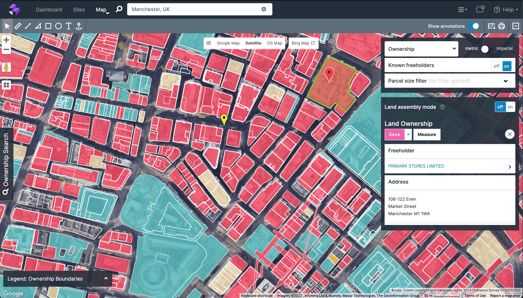
2. Efficient and effective site due diligence
Now you’ve spotted the opportunity, it’s time to do some digging to see if the glitter really is gold.
You’ve got to take an in depth look at planning application data, ownership structures, purchase history, area details etc. A lot of information, which means a lot of work on your part.
You could spend an endless amount of time gathering this information from different sources, like an obsessed detective. Painstakingly compiling all that information into a spreadsheet.
Eventually, you’d come to your conclusion. But at what cost?
How tech makes the difference
Or you could do it in a relaxed manner, sipping your favourite drink in a fraction of the time using LandInsight.
Planning application history *click*
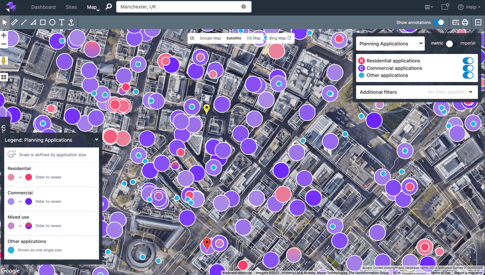
Comparable information *click*
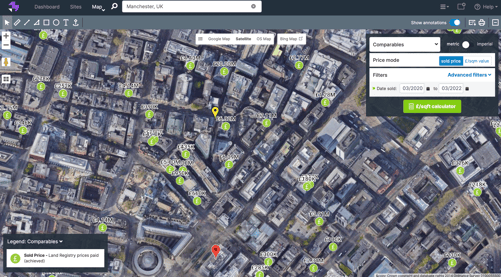
Use class *click*
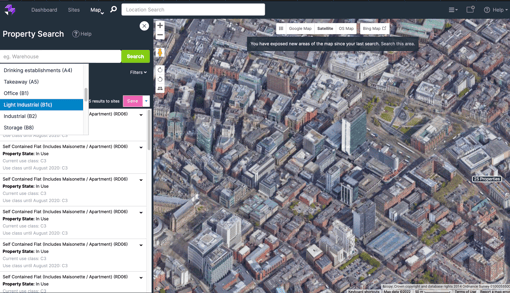
3. Negotiate with the site owner
So you’ve done your research, and it turns out that if you play your cards right, you may be onto a gold mine. Firstly though, you’ve got to present the owner with an offer they can’t refuse…without the mafia-esque intimidation of course. Do the EUV and the GDV get on?
How tech makes the difference
Technology isn’t quite as impactful here, as writing letters is still the common way to communicate your offer. However, you’ll probably be in a better mood and have more time to craft a letter because you’ve used digital tools to speed up the process thus far.
The sites pipeline within LandInsight can help you to keep track of who you’ve contacted and when, and when a follow up letter (if needed) would be most impactful. This makes sending the letters out a bit easier, especially if there are lots of them. No risk of wrong names or addresses, always good to get information right when you’re trying to sell something.
4. Get optimum planning ASAP
The grand plan is in place, now you need to convince the other people (LPAs) that it’s incredible too. Some developers say that this is the hardest part of the process. Depending on what and where you’re building it certainly can be.
How tech makes the difference
To make life easier for yourself you can use a tool like LandEnhance, which standardises and speeds up the process of getting the planning permission you want. You can quickly search through policy documents, planning applications and appeals. You can also filter by decision, location, type and age.
5. Find, evaluate and fund your project
Planning permission secured. You could have a project that could shift the industry forever, but if you can’t get it funded it will forever remain an idea on paper. This is the final hurdle before you can break ground, and arguably (along with planning permission) the most difficult hurdle to clear.
You’ve got to convince funders that lending you money for your project is financially a good idea for them, as well as you. Never easy, but then if this was easy, wouldn’t everyone be doing it?
How tech makes the difference
LandFund simplifies the development appraisal process by allowing you to do the following:
- Assess the profitability of your site
- View residual land values
- Conduct sensitivity analysis
- Create instant cashflows
- Build reports
- Link build phases to unit groups
- Create your own custom templates in under a minute, no that’s not an exaggeration
We’re also working on a lender matching service that will make finding the right lender for you a more seamless process.
This is what you'll see if you were to build an appraisal on LandFund.
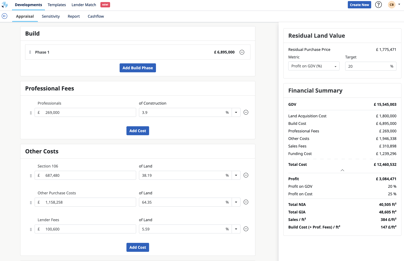
6. Break ground
We’ll let you and your build team take it from here. But we’re always available if you need to tweak anything, or adapt to (sometimes) merciless market conditions.
Now we’ve told you how tech can make your life easier, how about we show you too?
Click the button below to get your free demo.

